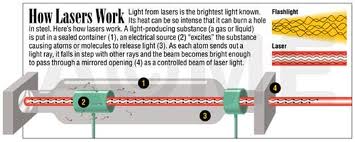

I want to spend some time discussing lasers and how we use them today. Lasers have been around for some time. In the past, at least as far as medicine is concerned, they have been a technology looking for an application. In the past several years, improvements in technology have made them much safer and applications have greatly increased.
.jpg) Austin Powers....demonstrated his ignorance of laser technology. Lasers have been a mystery to most!!
Austin Powers....demonstrated his ignorance of laser technology. Lasers have been a mystery to most!!
Laser and intense light or flash lamp therapy are both based on concentrated light. Let's talk about lasers first.
.jpg?width=571&height=228&name=images_(9).jpg)
Lasers are concentrated light that can be used for multiple applications. They have been used in industrial applications for years. Medical lasers have numerous applications as well. We use them to to clear up and make skin look prettier. We use them to remove tattoo's. They are used to treat veins and vascular problems on the body and face, even varicose veins. We can remove unwanted hair, laser fat cells, make skin contract, use them to cut skin, and now we can treat toenail fungus which has been a nagging problem.
Pulsed light therapy is based on a bright flash of light shot onto the skin. Also called a flash lamp, this technology has been used for other applications, photography, etc. In cosmetic surgery we use it to treat spots and different pigments on the skin of the face or body.
Unfortunately, there is no single laser that can be used for all applications. Not to get too complicated (because it is complicated) the way we choose what laser or lamp to used is based on the chromophore we are trying to treat. A chromophore is the part of a molecule or cell that produces its color. Each laser or flash lamp has a wave length that attacks that color. This is why one laser or lamp will not work on all colors. We know what colors we are trying to treat and select the laser or lamp that will work on that specific color. This is where the art meets the science. With some applications, we are aiming at water in the skin as the chromophore, especially when resurfacing the skin.
The most common laser currently used in Cosmetic Surgery are the nd-YAG, the KTP, the CO2, and the pulsed dye lasers. Each of these target a different chromophore or color. The newest developments in the technology is the fractional and q-switched technologies. We used to resurface skin by ablating or lasering the entire skin surface. Since the skin recovers by healing from the hair follicle, recovery was slower than desired and this scared people. Fractional lasers give us the ability to divide or fractionate the pulse of light from the laser. This leaves islands of undamaged skin between the areas treated. There are more and larger areas for the skin to heal. The advantages are that healing is much faster and complication rates are less. The disadvantages are that the treatment is not quite as good and may require more than a single session. Q switching is a way to modulate the laser output to get a better "quality" of light energy, more intense output per pulse. I will talk more about Q-switching when I discuss tattoo removal.
Flash lamps also treat specific colors in the skin. They are used for treatment of brown pigment, red pigment, and hair in the treatment areas. With flash lamps, we must change the wavelength of the light to treat each problem.
Now that the boring part is over, next week we will begin to explore the problems we treat and what we use to treat them.
 Don't forget our nail fungus, lap band, and liposuction deals that are currently running. We also are having multiple Botox events in Tulsa and Grove to get everyone ready for the holidays!! Send me a message, fill out a contact form, or call 918-786-7780 to find out when and where.
Don't forget our nail fungus, lap band, and liposuction deals that are currently running. We also are having multiple Botox events in Tulsa and Grove to get everyone ready for the holidays!! Send me a message, fill out a contact form, or call 918-786-7780 to find out when and where.





 This picture illustrates normal valve activity.
This picture illustrates normal valve activity. The second image shows a comparison of normal with abnormal function. When these valves are defective, the blood is allowed to return down the leg, increasing pressure and causing tributaries to dilate and become tortuous. Spider veins also develope as the pressure causes enlargement of smaller veins in the skin. The disease is not limited to appearance either. This process causes cramping, restless leg syndrome, skin discoloration, rashes, ulceration with secondary infection, swelling, and ultimately, disability.
The second image shows a comparison of normal with abnormal function. When these valves are defective, the blood is allowed to return down the leg, increasing pressure and causing tributaries to dilate and become tortuous. Spider veins also develope as the pressure causes enlargement of smaller veins in the skin. The disease is not limited to appearance either. This process causes cramping, restless leg syndrome, skin discoloration, rashes, ulceration with secondary infection, swelling, and ultimately, disability.